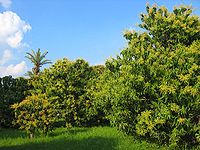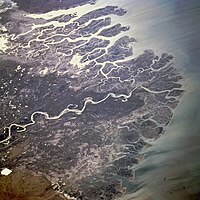
Mango Orchard in Multan, Pakistan
Contents
|
Early history
Barley and wheat cultivation—along with the domestication of cattle, primarily sheep and goat—was visible in Mehrgarh by 8000-6000 BCE.[1][2] Early Mehrgarh residents lived in mud brick houses, stored their grain in granaries, fashioned tools with local copper ore, and lined their large basket containers with bitumen. They cultivated six-row barley, einkorn and emmer wheat, jujubes and dates, and herded sheep, goats and cattle. Residents of the later period (5500 BC to 2600 BC) put much effort into crafts, including flint knapping, tanning, bead production, and metal working. The site was occupied continuously until about 2600 BC.[3]Irrigation was developed in the Indus Valley Civilization by around 4500 BCE.[4] The size and prosperity of the Indus civilization grew as a result of this innovation, which eventually led to more planned settlements making use of drainage and sewers.[4] Sophisticated irrigation and water storage systems were developed by the Indus Valley Civilization, including artificial reservoirs at Girnar dated to 3000 BCE, and an early canal irrigation system from circa 2600 BCE.[5]
Archeological evidence of an animal-drawn plough dates back to 2500 BC in the Indus Valley Civilization.[6]
Rankings
Pakistan is one of the world's largest producers and suppliers of the following according to the 2005 Food and Agriculture Organization of The United Nations and FAOSTAT given here with ranking:- Chickpea (2nd)
- Apricot (4th)
- Cotton (4th)
- Sugarcane (4th)
- Milk (5th)
- Onion (5th)
- Date Palm (6th)
- Mango (7th)
- Tangerines, mandarin oranges, clementine (8th)
- Rice (8th)
- Wheat (9th)
- Oranges (10th)
Crops
The most important crops are wheat, sugarcane, cotton, and rice, which together account for more than 75% of the value of total crop output.Pakistan's largest food crop is wheat. In 2005, Pakistan produced 21,591,400 metric tons of wheat, more than all of Africa (20,304,585 metric tons) and nearly as much as all of South America (24,557,784 metric tons), according to the FAO[7]
Pakistan has also cut the use of dangerous pesticides dramatically. [1]
Pakistan is a net food exporter, except in occasional years when its harvest is adversely affected by droughts. Pakistan exports rice, cotton, fish, fruits (especially Oranges and Mangoes), and vegetables and imports vegetable oil, wheat, cotton, pulses and consumer foods. The country is Asia's largest camel market, second-largest apricot and ghee market and third-largest cotton, onion and milk market.
The economic importance of agriculture has declined since independence, when its share of GDP was around 53%. Following the poor harvest of 1993, the government introduced agriculture assistance policies, including increased support prices for many agricultural commodities and expanded availability of agricultural credit. From 1993 to 1997, real growth in the agricultural sector averaged 5.7% but has since declined to about 4%. Agricultural reforms, including increased wheat and oilseed production, play a central role in the government's economic reform package.
Much of the Pakistan's agriculture output is utilized by the country's growing processed-food industry. The value of processed retail food sales has grown 12 percent annually during the Nineties and was estimated at over $1 billion in 2000, although supermarkets accounted for just over 10% of the outlets. [2]
The Federal Bureau of Statistics provisionally valued major crop yields at Rs.504,868 million in 2005 thus registering over 55% growth since 2000 [3] while minor crop yields were valued at Rs.184,707 million in 2005 thus registering over 41% growth since 2000.
Livestock
According to the Economic Survey of Pakistan,[8] the livestock sector contributes about half of the value added in the agriculture sector, amounting to nearly 11 per cent of Pakistan's GDP, which is more than the crop sector.The leading daily newspaper Jang reports that the national herd consists of 24.2 million cattle, 26.3 million buffaloes, 24.9 million sheep, 56.7 million goats and 0.8 million camels. In addition to these there is a vibrant poultry sector in the country with more than 530 million birds produced annually. These animals produce 29.472 million tons of milk (making Pakistan the 5th largest producer of milk in the world), 1.115 million tons of beef, 0.740 million tons of mutton, 0.416 million tons of poultry meat, 8.528 billion eggs, 40.2 thousand tons of wool, 21.5 thousand tons of hair and 51.2 million skins and hides.[9]
The Food and Agriculture Organization reported in June 2006 that in Pakistan, the world's fifth largest milk producing country, government initiatives are being undertaken to modernize milk collection and to improve milk and milk product storage capacity.[10]
The Federal Bureau of Statistics provisionally valued this sector at Rs.758,470 million in 2005 thus registering over 70% growth since 2000.[11]
Fishery
Main article: Fishing in Pakistan
Fishery and fishing industry plays an important role in the national economy of Pakistan. With a coastline of about 814 km, Pakistan has enough fishery resources that remain to be fully developed. It is also a major source of export earning.Forestry
Main article: Forestry in Pakistan
About only 4% of land in Pakistan is covered with forest sand. The forest of Pakistan are a main source of food, lumber, paper, fuelwood, latex, medicine as well as used for purposes of wildlife conservation and ecotourism.




No comments:
Post a Comment